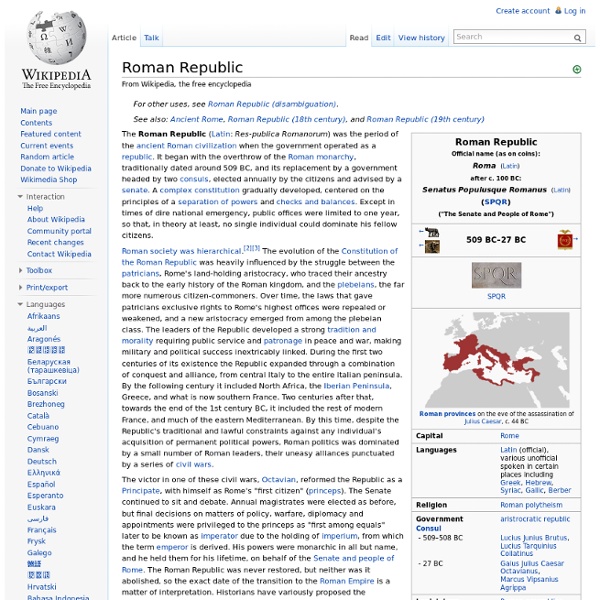Roman Republic

Roman Kingdom
The Roman Kingdom (Latin: REGNVM ROMANVM) was the period of the ancient Roman civilization characterized by a monarchical form of government of the city of Rome and its territories. Little is certain about the history of the kingdom, as nearly no written records from that time survive, and the histories about it that were written during the Republic and Empire are largely based on legends. However, the history of the Roman Kingdom began with the city's founding, traditionally dated to 753 BC with settlements around the Palatine Hill along the river Tiber in Central Italy, and ended with the overthrow of the kings and the establishment of the Republic in about 509 BC. Origin[edit] The traditional account of Roman history, which has come down to us through Livy, Plutarch, Dionysius of Halicarnassus, and others, is that in Rome's first centuries it was ruled by a succession of seven kings. Monarchy[edit] Chief Executive[edit] Chief Priest[edit] Chief Legislator[edit] Chief Judge[edit] Early Rome
Ancient Rome — History.com Articles, Video, Pictures and Facts
The decadence and incompetence of Commodus (180-192) brought the golden age of the Roman emperors to a disappointing end. His death at the hands of his own ministers sparked another period of civil war, from which Lucius Septimius Severus (193-211) emerged victorious. During the third century Rome suffered from a cycle of near-constant conflict. A total of 22 emperors took the throne, many of them meeting violent ends at the hands of the same soldiers who had propelled them to power. Meanwhile, threats from outside plagued the empire and depleted its riches, including continuing aggression from Germans and Parthians and raids by the Goths over the Aegean Sea. The reign of Diocletian (284-305) temporarily restored peace and prosperity in Rome, but at a high cost to the unity of the empire. The stability of this system suffered greatly after Diocletian and Maximian retired from office. Access hundreds of hours of historical video, commercial free, with HISTORY Vault.
Related:
Related:



